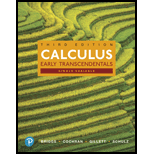
Concept explainers
Explain why or why not Determine whether the following statements are true and give an explanation or counterexample.
- a. A region R is revolved about the y-axis to generate a solid S. To find the volume of S, you could either use the disk/washer method and
integrate with respect to y or use the shell method and integrate with respect to x. - b. Given only the velocity of an object moving on a line, it is possible to find its displacement, but not its position.
- c. If water flows into a tank at a constant rate (for example 6 gal/min), the volume of water in the tank increases according to a linear function of time.
(a)
Whether the statement “A region R is revolved about the y axis to generate a solid S. To find the volume S, you could use either the disk/ washer method and integrate with respect to y or the shell method and integrate with respect to x.” is true or false.
Answer to Problem 1RE
The statement is true.
Explanation of Solution
The shell method is a method of finding volumes by decomposing a solid of revolution into cylindrical shells.
Suppose that a thin vertical strip is revolved about the y axis. An object of revolution (one that looks like a cylindrical shell or an empty tin can with the top and bottom removed) is obtained.
Then the resulting volume of the cylindrical shell is the surface area of the cylinder times the thickness of the cylindrical wall, which is shown below.
Disk method models the resulting three dimensional shape as a stack of an infinite number of disks of varying radius and infinitesimal thickness.
This is in contrast to shell integration which integrates along the axis perpendicular to the axis of revolution.
Thus, the given statement is true.
(b)
Whether the statement “Given only the velocity of an object moving on a line, it is possible to find its displacement, but not its position.” is true or false.
Answer to Problem 1RE
The statement is true.
Explanation of Solution
In order to find the displacement between two time periods, it is required to integrate the velocity between given time periods.
To evaluate the position at any time, that is either the initial position of the object at any given time or at least the position of the object at a particular time is required.
Thus, the given statement is true.
(c)
Whether the statement is “If water flows into a tank at a constant rate (for example 6gal/min.), the volume of water in the tank increases according to a linear function of time” is true or false.
Answer to Problem 1RE
The statement is true.
Explanation of Solution
If
Here the rate of inflow is in units of volume per unit time.
Hence, the change in volume in the tank will also be linear.
Thus, the given statement is true.
Want to see more full solutions like this?
Chapter 6 Solutions
Calculus, Single Variable: Early Transcendentals (3rd Edition)
- Find the exact area inside r=2sin(2\theta ) and outside r=\sqrt(3)arrow_forwardA 20 foot ladder rests on level ground; its head (top) is against a vertical wall. The bottom of the ladder begins by being 12 feet from the wall but begins moving away at the rate of 0.1 feet per second. At what rate is the top of the ladder slipping down the wall? You may use a calculator.arrow_forwardExplain the focus and reasons for establishment of 12.4.1(root test) and 12.4.2(ratio test)arrow_forward
- Use 12.4.2 to determine whether the infinite series on the right side of equation 12.6.5, 12.6.6 and 12.6.7 converges for every real number x.arrow_forwarduse Cauchy Mean-Value Theorem to derive Corollary 12.6.2, and then derive 12.6.3arrow_forwardExplain the focus and reasons for establishment of 12.5.4arrow_forward
 Elementary Geometry for College StudentsGeometryISBN:9781285195698Author:Daniel C. Alexander, Geralyn M. KoeberleinPublisher:Cengage Learning
Elementary Geometry for College StudentsGeometryISBN:9781285195698Author:Daniel C. Alexander, Geralyn M. KoeberleinPublisher:Cengage Learning Elementary Geometry For College Students, 7eGeometryISBN:9781337614085Author:Alexander, Daniel C.; Koeberlein, Geralyn M.Publisher:Cengage,
Elementary Geometry For College Students, 7eGeometryISBN:9781337614085Author:Alexander, Daniel C.; Koeberlein, Geralyn M.Publisher:Cengage, Holt Mcdougal Larson Pre-algebra: Student Edition...AlgebraISBN:9780547587776Author:HOLT MCDOUGALPublisher:HOLT MCDOUGAL
Holt Mcdougal Larson Pre-algebra: Student Edition...AlgebraISBN:9780547587776Author:HOLT MCDOUGALPublisher:HOLT MCDOUGAL Mathematics For Machine TechnologyAdvanced MathISBN:9781337798310Author:Peterson, John.Publisher:Cengage Learning,
Mathematics For Machine TechnologyAdvanced MathISBN:9781337798310Author:Peterson, John.Publisher:Cengage Learning, Trigonometry (MindTap Course List)TrigonometryISBN:9781305652224Author:Charles P. McKeague, Mark D. TurnerPublisher:Cengage Learning
Trigonometry (MindTap Course List)TrigonometryISBN:9781305652224Author:Charles P. McKeague, Mark D. TurnerPublisher:Cengage Learning Big Ideas Math A Bridge To Success Algebra 1: Stu...AlgebraISBN:9781680331141Author:HOUGHTON MIFFLIN HARCOURTPublisher:Houghton Mifflin Harcourt
Big Ideas Math A Bridge To Success Algebra 1: Stu...AlgebraISBN:9781680331141Author:HOUGHTON MIFFLIN HARCOURTPublisher:Houghton Mifflin Harcourt





